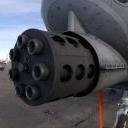Leaderboard
Popular Content
Showing content with the highest reputation on 01/23/2020 in all areas
-
I could have sworn there was already a discussion started on this somewhere buried in another thread but I can't seem to find it. Is anybody else starting to think this plane might never fly again? The fact that what Boeing keeps calling a simple software fix is now going for at least 16 months before recert by the FAA (assuming they don't delay it yet again this summer) doesn't inspire much confidence. Not to mention the other issues that keep cropping up in the news. Some of it I'm sure is not that unusual and is only newsworthy because of the grounding but it's a pretty bad look. I hear lots of people claiming they won't ever fly on a MAX but I don't really believe them. My guess is that if the plane does get back in service people will see a Southwest flight for $100 less than a Delta flight and buy the ticket without a second thought for what plane they might be flying on. Either way this seems like a disaster for Boeing and everybody working the 320neo program must be in a great mood these days.1 point
-
You're not wrong. Here it is straight from that AD I linked earlier. My point though isn't so much that there's not a correction, or even training to handle similar issues, but that it's a matter of recognizing the issue. When the AoA fails and the aircraft suddenly pitches down the CAS throws a ton of warnings all not directly to the system that the pilots were never told was on the plane in the first place. It's easy to get caught up with a terrain alarm before catching the trim runaway. Yes, it's possible for the pilots to catch and correct the issue, even without specific training. But Boeing set the pilots up for failure while actively suppressing things that would make the aircraft safer. They never should have been in the situation of needing to figure it out without an extraordinary series of failures happening, not a single moderately likely failure. It's one thing if they overlooked it, an accident happened, they admit they ed up and correct it. But they knew there was a problem, they actively hid the problem, then when the problem killed 189 people they continued to try to hide the problem and blame the pilots. When they're finally forced to act they release an AD that downplays the problem as much as possible. Boeing had repeated opportunities to do the right thing and make the plane safer but strong armed their way through the process in the name of cutting cost. It would be great if we could say there's never going to be another accident in aviation. Our training is perfect, our systems are perfect, it's all hunky dory. But that will never happen. The best we can do, and are obligated to do, is to make things as safe as we can. Mistakes happen and people die. It's unfortunate but it happens, and we can accept that. This wasnt a mistake. This was deliberate corner cutting for profits over people, and that's unforgivable.1 point
-
You missed a big step in that “impossible” cockpit environment: flipping the runaway stab trim switch. It’s an emergency procedure that pilots should be ready for at any moment and would stop MCAS from the ability to trim further. And in the Boeing system, once you flip it off you NEVER turn it back on. All the design changes were not great, single AoA sensor not great, but that’s a critical response you train to do in less than 3 seconds. Nope, it wasn’t in an extended manual T.O., still a foul, but I understand why they thought the corrective action could be done in 3 seconds. Because it’s the same corrective action already trained to for runaway stab trim.1 point
-
Can confirm the B-1 bit. The Dyess Reserve folks won't have a UPT board till 2023. As for the Missouri B-2s they just had a UPT board but it was open to only for folks who were currently in the Missouri Air National Guard. The POC said they occasionally will recruit UPT from the outside but it depends on the year. Hope this helps some folks.1 point
-
The AD after the first crash, btw: https://theaircurrent.com/wp-content/uploads/2018/11/B737-MAX-AD-1107.pdf No mention of the level of urgency required. The AD just says hey, look for these things and doesn't mention you have 3 seconds to figure it out and 10 seconds to correct or it's irrecoverable. IMHO this isnt a civil issue, it's a criminal one. But what do I know.1 point
-
I'll preface this with I know it kind of contradicts what I said above but only to a point (y'all got me reading a lot more into this). The initial motivation between an update vs clean-sheet wasn't cost, it was competition, but at the end it was still a series of decisions driven by money not sound engineering or safety. The 737 wasn't supposed to be updated. I won't say never but the actual plan in 2006 was to replace the aircraft with a clean-sheet design following the 787. They kept putting off deciding on the new design until in mid-2010 they committed to making a decision in 2011. Enter Airbus in December 2010 announcing the A320neo program and securing an order of hundreds of planes from the then Boeing dominated American Airlines fleet. The downside for Airbus was that the contract with American hindered their ability to make deal with other airlines, giving Boeing time to react. Boeing pushes off the new airplane to 2030 and rushes to build a more efficient 737 to secure their dominance with other airlines. "Easiest" way to increase efficiency? Larger engines with higher bypass ratios (they also made some aero/weight changes but that's the big one). The problem is the original 737 was designed with thin turbojets, not turbofans, and also designed to sit as low as possible for weight and maintenance. The new engines don't fit under the wing so they moved them forward, up, and I think slightly in as well. This put them more forward of the lateral axis, increasing moment. Not only that, the engine nacelles themselves now generated a fair bit more lift. This came to a head when doing high speed stall testing where the aircraft would perform relatively as expected but the stick wouldn't The forces on the stick would suddenly drop off through the stall due to the increased lift on the nacelles. FAA cert requirements say that the forces on the stick have to make smooth changes. So while the aircraft was still safe to fly, it didn't meet cert requirements. Enter MCAS. The first iteration used the AoA sensor and a g-input to determine if the aircraft was entering a high speed stall and adjusted the elevator by up to 0.6 degrees to compensate. Test pilots say it works beautifully and the program continues. Some more test flights and the same stick load issue is discovered during low speed stalls as well. Lower airspeed means larger deflections are required to control the aircraft, and their won't be excessive g-forces to trigger the MCAS system. So Boeing scraps the g-force input, ups the amount of authority of the MCAS system, and allows in to activate multiple successive times in a row stacking the pitch change. Note that while they scrapped the g-input and the 737 has two AoA sensors, they never update it to read more than one. Test pilots, engineers, designers all raise concerns but are shouted down and literally told "Don't rock the boat." The safety assessment relies on the pilots assessing and correcting a runaway pitch condition within 3 seconds, which was never going to happen for several reasons. The accidents that happened were caused when that single AoA sensor failed and the MCAS system activated. A pilot may recognize a single specific issue in 3 seconds but that's not the cockpit environment when an AoA sensor fails. Master warning, stall warning, stick shaker, TAWS, overspeed, wildly spinning trim wheel, and who knows what else all suddenly comes on at the same time. The pilot figures out that nose is pitching down and yanks the yoke. Too bad the force required to pull up is suddenly well over 40 or 50 pounds. The pilot recognizes the runaway elevator and does the standard procedure of hitting the trim switch to correct. Too bad the MCAS system disables the yoke trim switch when it's activated. Go to the flight manual for the runaway elevator procedure to see what to do about MCAS. Except there's nothing in there about it. Boeing made an extremely conscious decision to leave it out. Transition training from the older 737s to the max? Nothing about MCAS was there either. So in the aftermath people turn to Boeing for answers. Why wasn't it designed safer? Why was the system reliant on a single input? Why weren't the pilots trained? Boeing's response: We did everything right. The system passed the legal requirements, our system safety assessment showed it was safe per the requirements, and the training provided was more than enough for the pilots. One hour on an iPad. You want to know why those planes crashed? Ask the pilots flying them. (This response was disgusting then and more so now with this next part coming to light). People probe deeper and the truth comes out. MCAS was a band-aid. It was tested in its original form but not in it's second evolution. Why? Because management actively suppressed flight testing of it. A new system safety report wasn't written for the new system. Why? They did a back of the envelope calculation and figured they didn't have to. The flight manual didn't continue info about MCAS or how to disable it. Why? Boeing worked very hard to convince the FAA that they didn't need it. They didn't want people to be aware of how different the aircraft really was (various reasons for that, but it all comes back to money). There was no real training program for the transition pilots. Why? Same as above. So where are we now? The FAA is auditing everything Boeing has, likely finding more issues. That'll happen, there's an absolutely insane amount of documentation, mistakes are going to happen, mostly innocent ones. Boeing is losing huge amounts of money due to the grounding and lost faith in their safety. Customers losing faith in Boeing products, but this is absolutely true: Boeing continues to insist they bear no fault and people shouldn't stop trusting them. And 346 people are dead. Gone. Never to be seen again. All because Boeing couldn't be bothered to change an 'if/then' statement to 'if/if(and)/then/else'.1 point
-
Whoa. Just posted. Her last video posted was in loving memory. Now this. Yikes. I have a feeling this vid will disappear quick. To weird not to.1 point
-
I lived IVO Tanque Verde/Sabino Canyon, just north of the Tanque Verde wash and drive to work was 15-20 min depending on gate traffic. It was 20 minutes to pretty much everywhere in tucson. Loved the area! In general, I'd recommend living north of the river.1 point
-
Short answer: it's a cluster. There's nothing cheap about aviation, add in that parts are one off and don't benefit from economies of scale and that $200,000 system is now an $800,000 system to manufacture. Oh, the FAA iterated requirements? Do it again. It failed a half million dollar test? Do it again. Safety analysis says it's no good? Do it again. Customer changed their mind? Do it again. Why didn't Boeing redo the system safety assessment after the MCAS change? That report alone likely cost millions to write. That sounds insane? Well that report is fed by hundreds of other reports, each fed by a few to several dozen other reports, each taking anywhere from 10 to 1000 man hours to write, all written by specialist engineers (like myself) all making $40-$100 an hour. That's just for the writing and analysis. A fire test on a relatively small part can cost upwards of $100k. Just the cowling, thrust reverser, and some of the tubing around the engines of the new G500 cost over a quarter billion.1 point
-
I thought it was a decent program, then again, I'm kind of book nerdy like that and enjoy discussing war and politics with other smart people. I went in 2015 before we had our contract and while I was on first-year pay working weekends and holidays. It was more than a little bump in both pay and QOL to go to ACSC vs endure first 1 and year 1.5 pay and seniority for me. Also, it helped that i lived somewhat locally to Montgomery and didn't have to move the family the family there. Now, I would not even contemplate war college or anything long like that because it would definitely be a cut in pay and QOL at this point. But ACSC worked for me at the time.1 point
-
It's less engineers/lawyers as engineers/bean counters, at least from what I've seen on both hardware and software cert. Certifying clean sheet aircraft, especially part 25, is stupid expensive so incremental design makes sense. But then they no doubt had engineers screaming about why problems and finance came down and pressured the UMs to save a buck and approve it anyway instead of spending the time and money to do it right. The problem is for a publicly traded company to be successful it can't just be profitable, it needs to be increasingly profitable, which is absolutely unsustainable. Boeing needed new sales to increase profits, so new plane. Fine, makes sense. While they can more than afford a clean sheet design it cuts too heavily into profits, so iterate an existing design. OK, fine, happens all the time. But issues come up from trying to staple those huge engines to an aircraft never designed to carry them. Hardware fix is affordable but again, cuts into profits so they can't post growth. Software is cheaper so just do that. The software fix sucks and doesn't work, but the bean counters already figured the were going to make X dollars and it just hurts too much to make less than that, so lean on the UMs to get them to sign it off anyways. Besides, pilots are smart, they'll know what to do. Except you never gave them a proper training program (too expensive and it would draw attention to the flaws in the design) and you laughed at the pilots that asked for one. You don't know what to do when the aircraft is nose low? Idiot. Never mind that it's nose low because the aircraft forced it there, and we never told you how to stop it from doing that. So now instead of spending X dollars on doing it (mostly) right the first time they're spending 10X dollars fixing it as the FAA audits everything after a lot of people died. Not to mention lost revenue from sales as those planes pile up on the ground. All because fiscal quarters > long term profitability > any kind of moral responsibility. Don't be shocked if those audits find issues endemic to the 737 platform and it has repercussions outside of just the MAX series.1 point
-
The only reason for the this rusty coat hangar abortion that is MCAS is Boeing trying to squeeze blood out of the turnip. Here's hoping more heads roll and they reevaluate the engineer to lawyer ratio on their books. This is what happens when you care more about profits (and investors) than the people who provide those profits. It's mind boggling that someone can saddle a company with a clusterfuck like this and bail with millions.1 point
-
A lot of guys are doing this now. The guys I know that work at the mil desks for the airlines think this is the min-run scenario to keep you off the bad-boy list. Getting off probation fully is the brass ring, but getting through consolidation is where most places won't give you the hairy eye-ball. To me that makes no sense at all - if you are out more than a couple of months you have to go back through training. They say training takes 2 years of flying the line to recoup the cost. Not sure why they would "like it" for people to come out for 100 hours then bounce. Oh well, just another thing I don't understand about the airline. FWIW, I did the full year - got off probation in about 8 months (@ DAL it's 400 hours of flying or 1 year on the line). I wanted to be off of probation but I also wanted to know if I'd hate it or not. That way I'd have 5 years of leave to find something better. I ended up not hating it at all. I retire this fall and can't wait to go back.1 point
-
"The best" fluctuates as contracts change. Also part of what is considered "the best" is where your seniority will be for the duration of your expected career, and in what base/equipment/seat. There is no perfect contract at any airline. A contract governs everything from pay, work rules, profit sharing, sick, vacation, trip construction, medical, insurance, scope, hotels, and just about everything else that can affect your pay/QOL/time off. Regarding seniority, movement is dependent on 2 things: growth and retirements. Only one of those is certain: retirements. Growth can be halted overnight (or be negative if planes are parked overnight if say a 9/11, recession, or fuel price spike happens). Airlines are a for profit company...when planes get parked overnight, pilots are on the street (furloughed). So financial health of a company also matters in that equation, to some degree. Delta has hired around 5k pilots since 2014. A lot of those are younger guys, and you'll never be senior to them if you are getting in now. UA has hired less than that, and AA has hired even less. Also, AA has hired a lot of Envoy flows who waited 15-18 years to flow, and they will age out sooner than many off the street hires. In other words, a lot of their hires have been older than the guys Delta has hired. The result of that is AA has the most retirements over the next 10-15 years, so movement there will be the most rapid. United is close behind them with retirements. Then comes Delta, then the rest (I think FDX, then UPS). SWA/JB/the others all have a lot fewer retirements. This means slower movement...although likely more growth at JB/Spirit/Frontier which kind of makes up for the lack of retirements, assuming the growth isn't interrupted. Also of note, Delta JVs out a lot of their wide body flying, so AA/UA have a lot more own metal wide body flying, thus more widebodies, thus more lucrative WB jobs in both seats, which will affect relative seniority, even on the NB side. A lot of guys will choose WB FO over NB CA. Overall, I'd say Delta's contract is the best, followed by United, then AA. But each has strengths and weaknesses. Delta's profit sharing is insane (16.6% for 2019...extra 2 months of pay). Their sick accrual is also leaps and bounds above everyone else. United has airport reserve (fk that). AA has lots of weak points. But all 3 are in negotiations, and those things are all on the table and could shift. Right now Doug Parker at AA told the pilots they have $150mil to make whatever improvements they want...that's chump change for 15,500 pilots given how far behind their contract is. United has Scott Kirby at the helm hellbent on more/larger RJs. Delta mgmt just filed for mediation, seemingly far apart with DALPA's asks. Right now, the financials of Delta support the most gains (or at least keeping the best contract), followed by UAL, followed by YUGELY debt-ridden AA. Doug says he will pay all that debt down. I'll believe it when I see it...but I doubt he gives AA pilots a contract anywhere near Delta's. But their seniority movement and bases may work better for people who live in say Dallas Charlotte or Miami. All 3 have fairly quick upgrades (albeit in less desirable bases), unheard of seniority movement/hiring/retirements, and are all likely going to trade off who "the best" is over the next 10/20/30 years. None has ever stayed "the best" forever. Southwest and JB have never furloughed, never gone through a bankruptcy, and have always remained profitable, even when the legacies hemorrhaged money, furloughed, went through BK, and all came out of BK with garbage concessionary contracts. The pecking order is this: go to who calls first. If 2 or 3 call, go to whichever one has a domicile you want to live at. If you live in a domicile of another airline you want to work at, keep applying there. Commuting to the airline with the best contract is worse than driving to work under the worst contract. For anyone considering entering the airline industry, or anyone who is in the airline industry and hasn't read it, I urge you to read "Hard Landing." It gives a nice history of the industry, all the players, and how all the airlines came to be. It gives a good history of who the biggest and best airline has been throughout history. In closing, there is a pecking order, but it changes. You won't know where you will end up in that pecking order until you retire. In 20-30 years from now when you retire from the airlines, the landscape will have changed tremendously, as will the pecking order. Best advice: make the best decision for you and your family now, sock money away and live like an FO even when you upgrade, hold on, and enjoy the ride. The only constant in the airlines is change. A lot of the bros getting into the industry in the last 5ish years only know the good times. It will not be good forever. When it isn't good, the pecking order of which airlines are the best tends to change. Delta is printing money right now with unprecedented profitability. But if you got hired there in the early 90s you got furloughed, went through a bankruptcy, lost a pension, took a few pay cuts, and likely never saw the left seat. But if you were hired there 5 years ago, you would be a NB Captain or WB FO today. TL;DR: Best contracts: Delta, United, American Best movement ahead: American, United, Delta Best financial health: Delta, United, American1 point
-
Many years back (i.e. the good 'ol days) during Friday night fighter pilot bar Olympics, a dude trying to be funny came behind my wife and was inappropriate. Being the confident woman she is, she turned and delivered a nicely executed elbow to the face knocking the dude to the ground and leaving an impressive black eye as a reminder not to mess with her. No attorneys were required.1 point
-
If my son had been accused then found guilty by a military investigation of grinding against another mans wife.....I mean, do I really have to tell you what I would do to my son for that? Yes, sometimes women lie. Sometimes CDIs go sideways. But it isn’t a stretch to believe that a man, while drinking, touched this woman sexually in an unwanted manner. A better question is: what would you do if this were your wife? “C’mon honey, he’s a good dude.” Let me know how that goes.1 point











